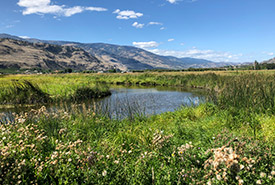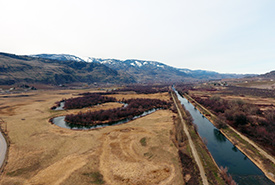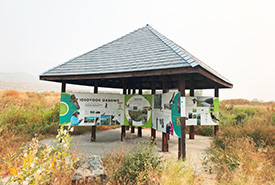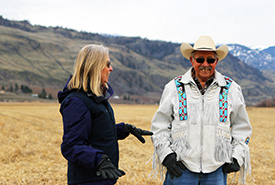Osoyoos Oxbows

Osoyoos Oxbows post-restoration in 2019 (Photo by NCC)
The Osoyoos Oxbows are a serpentine network of wetlands that are scattered along a stretch of British Columbia’s South Okanagan Valley between Osoyoos and Oliver.
Oxbows are wetland channels that have been cut off from the main river. The handful of marshes that make up the Osoyoos Oxbows today are remnants of what was once a significant chain of wetlands. These wetlands formed in the original, free-flowing path of the Okanagan River, which was straightened in the 1950s to control flooding. The wetlands were then filled in and the land used for agriculture, contributing to the significant loss of wetland habitat in this province. Today an estimated 85 per cent of valley-bottom wetlands have been lost to urban and agricultural development.
The Osoyoos Oxbows area is famous for its bird watching opportunities and is designated an Important Bird Area in recognition of the diversity of bird species that rely on these lands for breeding, nesting, hunting and as a critical migration stopover.
Here, you can spot long-billed curlew, sandhill crane, red-tailed hawk and many types of waterfowl. If you are lucky you might even see a bobolink, an at-risk songbird that uses the Osoyoos Oxbows as its only breeding grounds in the Okanagan Valley.
Collaborative conservation

Osoyoos Oxbows, South Okanagan Wildlife Management Area, Okanagan river (from left to right) (Photo by Tim Feeney)
Like all wetlands, oxbows are very biologically productive, providing shelter, food and reproductive habitat for a huge number and variety of species. The high conservation value of the Osoyoos Oxbows has attracted a wide variety of land trusts and governments to get involved in conserving this important habitat. Over the past few decades, a connected corridor of conservation lands has come to protect a substantial portion of the oxbow area.
The Nature Conservancy of Canada (NCC) has two conservation properties here: Bobolink Meadows and the Ted Pendergraft and Sons Conservation Area. We collaborate closely with Ducks Unlimited Canada (DUC) on our work in this area, including on an extensive restoration project that has rebuilt about five hectares (about 12 acres) of wetland habitat.
Bringing back the wetlands
Wetland areas have a long history of being degraded and converted for other uses. In the South Okanagan Valley, an estimated 85% of streamside and wetland habitats have been lost, largely due to urban development and conversion to agriculture. Despite this, the valley remains one of the most abundantly biodiverse areas in the province.
NCC is actively working to recover lost wetland areas on its lands in the Osoyoos Oxbows. With the support of many funders and partners, we have recreated historic oxbow channels and planted over 1,000 native shrubs, forbs and trees to rebuild a thriving riparian area.
This ongoing restoration is enhancing essential habitat for numerous species at risk, including Great Basin spadefoot, western tiger salamander, western painted turtle and blotched tiger salamander.
We thank the South Okanagan Conservation Fund for their multi-year support of this critical restoration work.

Kiosk at Osoyoos Oxbows (Photo by NCC)
Exercise, education and inspiration
The Osoyoos Oxbows offers easy access to people of all abilities who want to enjoy a walk or bike in this beautiful area. Two community trails frame the area. The South Kettle Valley Railway Trail follows the western boundary of the conservation lands, while the International Hike & Bike Trail lies to the east and follows the Okanagan River channel for about 13 kilometres. Both trails provide great views of the wetlands and fields in which birds congregate. Binoculars are a must when visiting the oxbows!
At Bobolink Meadows, you will be able to see the recreated wetlands that have been enjoyed by growing numbers of waterfowl, songbirds and amphibians. At Ted Pendergraft and Sons Conservation Area a handy boot brush station offers tips on preventing the spread of invasive plants into conservation areas. The easy-to-use boot brush will remove any harmful seeds that may be stuck in the tread of your shoes.
Species to spot
The Osoyoos Oxbows is all about the birds! Listen for the music of songbirds and the hoots of owls. Watch for waterfowl in the marshes and hawks circling overhead. If you’re lucky, you might see long-billed curlew or bobolinks. And beyond birds, if you look closely along the water’s edge and you might spot a turtle, snake or salamander.
Download a Species to Spot checklist for Osoyoos Oxbows.
Partners in conservation
Many groups and individuals have supported the conservation and restoration of NCC’s lands at Osoyoos Oxbows:

Southern Interior program director Barbara Pryce and Jimmy Pendergraft at Osoyoos Oxbows (Photo by Tim Feeney)
- British Columbia Conservation Foundation
- Burrowing Owl Estate Winery
- Ducks Unlimited Canada
- Ellen Hardman Stuart
- Eva and Herbert Rosinger
- Government of Canada via the Natural Areas Conservation Program
- Habitat Conservation Trust Foundation
- Jean and Kenneth Finch
- McLean Foundation
- Norbury Foundation
- Okanagan Similkameen Parks Society
- Oliver Osoyoos Naturalist Club
- Rag and Dad, LLC
- Regional District of Okanagan-Similkameen
- Robert Foord
- Robert and Barbara Shaunessy
- South Okanagan Conservation Fund
- U.S. Fish and Wildlife Service
- Wyss Foundation
- and many other donors




